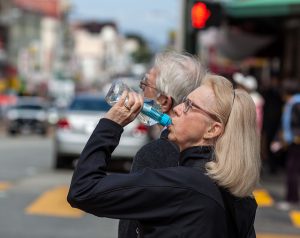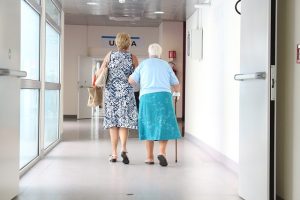GERD
Background
Although gastroesophageal reflux disease (GERD) is common among older adults, the true prevalence is not known. Many patients with GERD-related symptoms never discuss their problems with their primary care provider. GERD is thought to occur in 5–7% of the world’s population, with 21 million Americans affected (International Foundations for Functional Gastrointestinal Disorders, 2008). It is found in both men and women.
Signs and symptoms
Pathophysiological changes that occur in the esophagus, hiatal hernia, and certain medications and foods increase the risk for GERD. Obesity (Corely , Kubo, Levin et al., 2007) and activities that increase intra-abdominal pressure such as wearing tight clothes, bending over, or heavy lifting have also been linked to GERD (MedlinePlus, 2005a). The cardinal symptom of GERD is heartburn; however, older adults may not report this, but rather complain of other symptoms such as pulmonary conditions (bronchial asthma, chronic cough, or chronic bronchitis), a hoarse voice, pain when swallowing foods, chronic laryngitis, or non-cardiac chest pain (Pilotto & Franceschi, 2009). The chronic backflow of acid into the esophagus can lead to abnormal cell development (Barrett esophagus) that increases the risk for esophageal cancer.
Diagnosis
Older adults often have atypical symptoms, making the diagnosis of GERD very challenging. As people age, the severity of heartburn can diminish, while the complications, such as erosive esophagitis, become more frequent. Therefore, endoscopy should be considered as one of the initial diagnostic tests in older adults who are suspected of having GERD (Pilotto & Franceschi, 2009). Examination of the esophagus, stomach, and duodenum through a fiber-optic scope (endoscopy) while the person receives conscious sedation, allows the gastroenterologist to visualize the entire area, identify suspicious areas, and obtain biopsies as needed. Helicobacter pylori (H. pylori), a chronic bacterial infection in humans, is a common cause of GERD, affecting about 30% to 40% of the U.S. population. Testing for H. pylori can be done during the endoscopy or by other tests (Ferri, 2011).
Treatments
The objectives of treatment for GERD include: (1) relief of symptoms, (2) healing of esophagitis, (3) prevention of further occurrences, and (4) prevention of complications (Pilotto & Francheschi, 2009). Lifestyle and dietary modifications are important aspects of care. It is widely recommended that persons with GERD should stop smoking, limit or avoid alcohol, and limit chocolate, coffee, and fatty or citrus foods. Medications should be reviewed and offending medications modified, since certain medications decrease the lower esophageal sphincter (LES) tone, allowing acid to backflow into the esophagus. These include anticholinergic drugs, some hormones, calcium channel blockers, and theophylline. Avoidance of food or beverages 3–-4 hours prior to bedtime, weight loss, and elevation of the head of the bed on 6-to-8 inch blocks are some other interventions that may help alleviate symptoms. Pharmacological treatments with antacids in conjunction with histamine 2 (H2) -blockers (Tagmet, Zantac, Axid, and Pepcid) are used for mild GERD. If these are ineffective in controlling symptoms, then the proton pump inhibitors (PPIs) are the next drugs of choice. These include medications like Nexium and Dexilant. With lifestyle modifications and appropriate medications, older adults can manage their GERD symptoms so that quality of life is maintained.
Adapted from Mauk, K. L., Hanson, P., & Hain, D. (2014). Review of the management of common illnesses, diseases, or health conditions. In K. L. Mauk’s (Ed.) Gerontological Nursing: Competencies for Care. Burlington, MA: Jones and Bartlett Publishers. Used with permission.
http://www.mayoclinic.com/health/gerd/DS00967
Seniors and Addiction Rehab: What Do You Need to Know?

There are addiction rehab programs for seniors. Many people don’t consider seniors when they think of someone having an addiction. However, that may be a mistake. There are many seniors who experience chronic pain, grief, and other issues, which is why they may abuse drugs. The schedule will be customized to meet each individual’s addiction recovery needs.
Components of Treatment
It is helpful to know what the components of treatment will be, whether you or a senior in your life, needs to get treatment. Some of these components include the following:
● Group therapy
● Daily assessments
● Pain management
● Medication assessments
● On-site medical detox
● Psychological assessments
● Faith-based counseling
● Relapse prevention tips
● Family therapy
These components may vary depending on the addiction treatment center that is attended. You may also get yoga, physical therapy, exercise, and other treatments.
Symptoms and Signs of Substance Abuse
It can be even more troublesome when an addiction goes unnoticed or doesn’t get treated. This is why it is so essential to recognize the symptoms and signs of substance abuse in seniors. Some of these things include the following:
● Anemia
● Agitation
● Liver function issues
● Anxiety
● Personal cleanliness issues
● Mental ability changes
● Eating habit changes
● Depression
● Increased falls
● Drinking despite consequences
● Weakness
● Fatigue
● Incontinence
● Violence
● Hostility
● Memory lapses
● Irritability
● More confusion than normal
● Losing interest in enjoyable activities
● Not keeping in touch with friends or family members
● Marital issues
● Panic attacks
● Mood swings
● Slurring of speech
If you notice these symptoms and signs in a senior, be sure to try to get them help.
When it comes to seniors and addiction rehab, it is important to know all this information. Addictions can be dangerous for anyone, especially the elderly. Their organs and body systems don’t work as well, so it is much easier to get alcohol poisoning or overdose on drugs. If you are a senior with an addiction, you can get inpatient rehab for elders today.
Guest Blog: 5 Reasons It Is Important for Senior Citizens to Have a Medicare Plan
As we age, it becomes increasingly important to have a solid healthcare plan in place. Medicare is one of the most popular healthcare plans available for senior citizens, and there are many reasons why it is important to have coverage through this program. For instance, Medicare can help to cover the costs of hospital stays, doctor visits, and even prescription medications. Another reason Medicare is so important is that it can help fill in the gaps left by other types of insurance coverage. For example, if you have private health insurance, some services may not be covered by your plan. Medicare can help to cover those costs so that you don’t have to worry about them. Here is a look at five reasons senior citizens need a Medicare plan.
1. Cover the Costs of Hospital Stays
Senior citizens are prone to a variety of health issues that can require hospitalization. These issues include strokes and heart attacks, broken bones, and pneumonia. Medicare can help to cover the costs of these hospital stays, which can be very expensive. If you go without coverage, you may have a large hospital bill you will be responsible for paying. In cases where a senior citizen is sent to a nursing home after a hospital stay, Medicare can also help cover the stay’s costs.
2. Cover the Costs of Doctor Visits
As we age, we tend to see the doctor more often. This is due to various health issues that can come up as we get older. For instance, we may need to see the doctor for routine checkups and more serious problems. Medicare can help cover the costs of these doctor visits, saving senior citizens a lot of money. In addition, Medicare can also help to cover the costs of preventive care, such as mammograms and screenings for colon cancer. You don’t want to go without this coverage, as it could cost you a lot of money in the long run.
3. Cover the Costs of Prescription Medications
Another important reason senior citizens need to have a Medicare plan is that it can help cover the costs of prescription medications. As we age, we tend to take more prescription medications than we did when we were younger. This is due to various health issues that can come up as we get older. Medicare can help cover the costs of these medications, saving senior citizens a lot of money. Medicare can also help cover the costs of generic medications, which can be even cheaper than brand-name medications. However, it is important to note that Medicare covers not all drugs. You will need to check with your specific plan to see what is and is not covered.
4. Cover the Costs of Vision and Dental Care
Another important reason senior citizens need to have a Medicare plan is that it can help cover the costs of vision and dental care. Senior citizens need to see the dentist more often than they did younger. This is due to various health issues that can come up as we get older. Additionally, senior citizens often need glasses or contact lenses as they age. Medicare can help cover the costs of these vision and dental care services, saving senior citizens a lot of money.
5. Cover the Costs of Hospice and Home Health Care
Finally, another important reason senior citizens need to have a Medicare plan is that it can help cover the costs of hospice and home health care. Omaha Insurance solutions understand that the end of life can be difficult for individuals and their families and they make it easier to pick a medicare plan that will help with any cost there might be. Insurance companies offer hospice and home healthcare coverage through different medicare plans. Hospice care can help to provide comfort and support for those nearing the end of their life. Home health care can help provide care for those unable to care for themselves. This coverage can be very beneficial for the individual and their family.
Conclusion
There are many reasons why senior citizens need to have a Medicare plan. If you or someone you know is a senior citizen, it is important to ensure that you have a plan. Omaha Insurance can help you to find the right Medicare plan for your needs.


